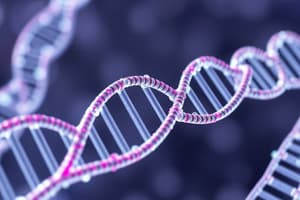Podcast
Questions and Answers
What technology is commonly used in SNP genotyping and mutation analysis?
What technology is commonly used in SNP genotyping and mutation analysis?
Pyrosequencing detects bases as they are being incorporated into the DNA strand.
Pyrosequencing detects bases as they are being incorporated into the DNA strand.
True (A)
What are Genome Wide Association Studies primarily used for?
What are Genome Wide Association Studies primarily used for?
To identify novel genes involved in disease or drug response.
The technology used in genotyping requires small sample volumes and is __________ sensitive and specific.
The technology used in genotyping requires small sample volumes and is __________ sensitive and specific.
Signup and view all the answers
Match the following methods with their primary usage in SNP genotyping:
Match the following methods with their primary usage in SNP genotyping:
Signup and view all the answers
Which of the following methods is NOT a manual DNA sequencing technique?
Which of the following methods is NOT a manual DNA sequencing technique?
Signup and view all the answers
Affymetrix microarrays use photolithographic synthesis to attach short DNA sequences to a solid surface.
Affymetrix microarrays use photolithographic synthesis to attach short DNA sequences to a solid surface.
Signup and view all the answers
What are the two main types of DNA sequencing methods?
What are the two main types of DNA sequencing methods?
Signup and view all the answers
In Sanger sequencing, ______ are incorporated into the growing DNA strand, terminating the synthesis at that position.
In Sanger sequencing, ______ are incorporated into the growing DNA strand, terminating the synthesis at that position.
Signup and view all the answers
Match the following terms with their corresponding descriptions:
Match the following terms with their corresponding descriptions:
Signup and view all the answers
Which of the following is NOT a benefit of next-generation sequencing (NGS)?
Which of the following is NOT a benefit of next-generation sequencing (NGS)?
Signup and view all the answers
In a typical GWAS Manhattan Plot, larger values on the Y-axis indicate weaker statistical evidence of association.
In a typical GWAS Manhattan Plot, larger values on the Y-axis indicate weaker statistical evidence of association.
Signup and view all the answers
What is the significance threshold used in a GWAS to correct for multiple testing?
What is the significance threshold used in a GWAS to correct for multiple testing?
Signup and view all the answers
In a GWAS Manhattan Plot, each point represents a ______ plotted based on its position in the genome.
In a GWAS Manhattan Plot, each point represents a ______ plotted based on its position in the genome.
Signup and view all the answers
Which type of DNA probe is used in Affymetrix microarrays?
Which type of DNA probe is used in Affymetrix microarrays?
Signup and view all the answers
In a typical GWAS Manhattan Plot, red plots indicate genome-wide significance, while green dots represent variants that are close to genome-wide significance.
In a typical GWAS Manhattan Plot, red plots indicate genome-wide significance, while green dots represent variants that are close to genome-wide significance.
Signup and view all the answers
What is the main advantage of exome sequencing compared to whole genome sequencing?
What is the main advantage of exome sequencing compared to whole genome sequencing?
Signup and view all the answers
The ______ is a glass slide coated with oligonucleotides complementary to the adapter sequences used in next-generation sequencing.
The ______ is a glass slide coated with oligonucleotides complementary to the adapter sequences used in next-generation sequencing.
Signup and view all the answers
What is the primary purpose of library preparation in next-generation sequencing?
What is the primary purpose of library preparation in next-generation sequencing?
Signup and view all the answers
Sanger sequencing is a high-throughput sequencing method that can be used to sequence entire genomes efficiently.
Sanger sequencing is a high-throughput sequencing method that can be used to sequence entire genomes efficiently.
Signup and view all the answers
Which method involves using a restriction enzyme that recognizes one allele but not the other?
Which method involves using a restriction enzyme that recognizes one allele but not the other?
Signup and view all the answers
The TaqMan system requires the use of a fluorescence detector during PCR reactions.
The TaqMan system requires the use of a fluorescence detector during PCR reactions.
Signup and view all the answers
What polymorphism is associated with slow acetylation of the chemotherapeutic drug Isoniazid?
What polymorphism is associated with slow acetylation of the chemotherapeutic drug Isoniazid?
Signup and view all the answers
PCR-RFLP makes use of a _________ which distinguishes between alleles based on the presence of a restriction site.
PCR-RFLP makes use of a _________ which distinguishes between alleles based on the presence of a restriction site.
Signup and view all the answers
What is the primary mechanism of the TaqMan system during PCR?
What is the primary mechanism of the TaqMan system during PCR?
Signup and view all the answers
Match the following genotyping methods with their descriptions:
Match the following genotyping methods with their descriptions:
Signup and view all the answers
MassARRAY can be used to apply assays to thousands of sites across many individuals.
MassARRAY can be used to apply assays to thousands of sites across many individuals.
Signup and view all the answers
What type of nucleotides are used when adding primers adjacent to a site of polymorphism in genotyping by primer extension?
What type of nucleotides are used when adding primers adjacent to a site of polymorphism in genotyping by primer extension?
Signup and view all the answers
Whole genome sequencing allows for mapping of all genetic variants, including those in non-coding regions.
Whole genome sequencing allows for mapping of all genetic variants, including those in non-coding regions.
Signup and view all the answers
What are the two main methods of sequencing mentioned?
What are the two main methods of sequencing mentioned?
Signup and view all the answers
Exome sequencing typically fragments DNA into pieces ranging from __________ base pairs.
Exome sequencing typically fragments DNA into pieces ranging from __________ base pairs.
Signup and view all the answers
Match the following terms with their definitions:
Match the following terms with their definitions:
Signup and view all the answers
Which process involves the use of biotinylated probes to isolate exonic regions?
Which process involves the use of biotinylated probes to isolate exonic regions?
Signup and view all the answers
Incidental findings are a potential disadvantage of exome sequencing.
Incidental findings are a potential disadvantage of exome sequencing.
Signup and view all the answers
What is a common disadvantage of whole genome sequencing?
What is a common disadvantage of whole genome sequencing?
Signup and view all the answers
During sequencing, DNA is typically sheared into fragments between __________ base pairs using various methods.
During sequencing, DNA is typically sheared into fragments between __________ base pairs using various methods.
Signup and view all the answers
Which of the following is NOT a phase in the data analysis process of whole genome sequencing?
Which of the following is NOT a phase in the data analysis process of whole genome sequencing?
Signup and view all the answers
Study Notes
Genotyping Methods for Polymorphisms
-
PCR-RFLP (Restriction Fragment Length Polymorphism): PCR amplifies a DNA region, then a restriction enzyme cuts the amplified DNA at specific recognition sequences. Different alleles have different restriction sites, leading to fragments of varying sizes. This difference in fragment length allows for the identification of different alleles.
-
Allele-Specific PCR: Primers that are designed to bind only to specific alleles are used. If a particular allele is present, the reaction will occur; otherwise, no amplification will occur.
-
Primer Extension Methods (e.g., Sequenom): A primer is extended by the addition of nucleotides. Techniques like mass spectrometry are used to determine the specific nucleotides added. This method can accurately identify the exact sequence at a specific site.
Drug Metabolism Polymorphisms
- Isoniazid Metabolism: A genotyping method will identify SNPs (single nucleotide polymorphisms) associated with slow acetylation of Isoniazid, an anti-TB drug. Slow acetylators may experience higher toxicity from Isoniazid and other drugs.
- T341C Mutation Identification: This is useful because it affects a restriction enzyme (DdeI) and causes a detectable size difference in the PCR product, aiding in allele identification.
Automated Allele-Specific PCR (e.g., TaqMan)
- TaqMan System: Uses fluorescent probes that bind only to specific alleles. The 5'-nuclease activity of Taq polymerase cleaves the probe, releasing the fluorescent reporter molecule, which signals the presence of a particular allele.
Genotyping by Primer Extension
-
MassARRAY and Pyrosequencing: These methods both use primer extension to identify polymorphisms.
- MassARRAY: Uses mass spectrometry to identify the sequence of added nucleotides. Very high-throughput.
- Pyrosequencing: Relies on detecting pyrophosphate release during nucleotide incorporation, which is measured optically. Can identify polymorphisms in known regions.
High-Throughput Genotyping: MassARRAY
- MassARRAY Technology: A high-throughput genotyping technique using MALDI-TOF mass spectrometry to identify genetic variations like SNPs. Its advantages include high throughput, scalability, high sensitivity and specificity, and low sample volume requirements.
Genotyping by Pyrosequencing
- Pyrosequencing: Measures the release of pyrophosphate during nucleotide incorporation to identify the sequence of a specific region. Creates a signal when the correct nucleotide binds. Useful for analyzing single polymorphisms, but can be scaled up with large-scale sequencing.
Genome-Wide Association Studies (GWAS)
-
GWAS Methods: High-throughput genotyping of thousands of SNPs across the genome is used to identify genetic variations associated with a specific disease or trait. Linkage disequilibrium is used for detecting associations with genes some distance away from the marker.
- Methods: Affymetrix and Illumina array technologies are common, enabling massive genotyping.
Affymetrix Microarray
- Microarray Technology: Attaches DNA probes to a solid surface, allowing for parallel analysis of thousands to millions of genetic markers. Detect hybridization of fluorescent DNA probes, enabling highly parallel screening.
GWAS Data Analysis: The Manhattan Plot
- Manhattan Plot: A graphical representation of GWAS results, plotting -log10(p-value) against genomic position. Significance is usually set to a threshold (e.g., 5x10^-8) to account for multiple comparisons.
Methods for Detecting New Polymorphisms
-
DNA Sequencing: Used to determine the exact sequence of DNA.
- Manual DNA Sequencing: (e.g., Sanger sequencing) relies on chain termination to determine the sequence.
- Advantages: high accuracy, easy interpretation;
-
Disadvantages: time-consuming, costly for large projects, limited fragment length.
- High-Throughput Sequencing: (e.g., next-generation sequencing) sequences many DNA fragments at once, allowing for rapid and comprehensive analysis;
- Advantages: high throughput, lower cost per sample, supports diverse applications;
- Disadvantages: short read lengths, potential data analysis challenges.
Whole Genome Sequencing (WGS) and Exome Sequencing (WES)
-
Whole Genome Sequencing (WGS): Sequences the entire genome.
-
Exome Sequencing (WES): Targets only the protein-coding exons of the genome, which often contain disease-causing mutations.
- Advantages (WES): More cost-effective than WGS, focused analysis of important regions.
- Disadvantages (WES): Limited coverage of non-coding regions and structural variants.
-
Differences in WGS Methodology: WGS uses fragmentation, adapter ligation, and various sequencing technologies (like Illumina or PacBio). Data analysis involves alignment, variant calling, annotation, and interpretation of identified variations.
-
WGS Advantages: Comprehensive coverage, flexible applications, long-term relevance.
-
WGS Disadvantages: Higher cost, large data volume, complex interpretation challenges, limitations of non-coding regions.
Studying That Suits You
Use AI to generate personalized quizzes and flashcards to suit your learning preferences.
Description
Explore various genotyping methods for polymorphisms, including PCR-RFLP, allele-specific PCR, and primer extension techniques. Understand their applications in drug metabolism, particularly focusing on isoniazid metabolism and SNP identification. Test your knowledge with this quiz on genetic analysis techniques.



